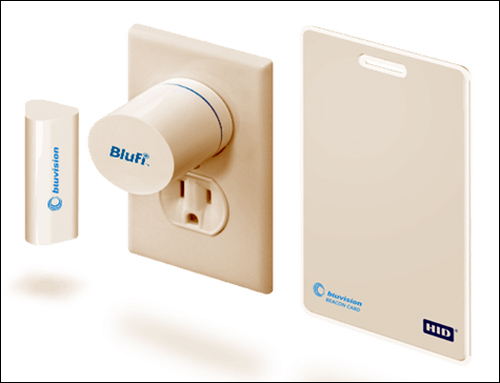Internet of Things technology company Bluvision (a part of HID Global) released an updated version of its Bluetooth Low Energy (BLE) real-time location system (RTLS) this spring that makes deployment of a typical RTLS solution possible within a matter of hours. The company calls its latest offering RTLS-EZ because users can simply plug BluFi gateways into outlets, input them into the cloud-based software, and begin using them. That makes RTLS deployments to track assets in real time faster than was possible with the previous version of its BLE solution, the company reports. The technology can also be used for workplace optimization when beacon tags are worn by individuals.
Like its predecessor, the RTLS-EZ system consists of Bluvision’s BLE beacons, Bluetooth- and Wi-Fi-enabled plug-in gateways, and the company’s Bluzone cloud-based software. With RTLS-EZ, however, improvements in the software enable an easier configuration of gateways so that the gateways can quickly determine their own location and those of the beacons that move around them, without the need for callibration.
In fact, says John Sailer, Bluvision’s COO, the system is so simple to install that by the fourth quarter of this year, the company plans to be able to ship the solution in a box for users to install themselves. He notes that traditional RTLS solutions with active RFID or ultra-wideband technology have been challenging to implement, since they typically require cabled readers, antennas, and sometimes exciters or repeaters to improve location granularity.
The Bluvision gateways, on the other hand, cost less than $50 apiece, and users pay for access by utilizing a software-as-a-service model. Therefore, deployment costs are minimal. If gateways are installed approximately 10 meters (32.8 feet) apart, Sailer says, they will typically provide location data within about a meter in a typical deployment. Bluvision makes its own gateway and beacon hardware and writes its own firmware.
The technology—either the RTLS-EZ version, announced at last month’s RFID Journal LIVE! conference, or the previous versions of the solution—is in use at about 50 locations, either in pilots or in permanent deployments.
For instance, an emergency vehicle manufacturer uses Bluvision’s RTLS beacons to track the locations of vehicles as they are being assembled, as well as following assembly before they are shipped to customers. It attaches Bluvision beacons (about the size of a AAA battery) to each vehicle and, with gateways deployed throughout the assembly plant, can identify when a vehicle reaches each work station. This helps the firm to manage where the vehicles are located, while also enabling operators access to information about the requirements for each assembled vehicle as it arrives at their station.
When vehicles leave the plant floor for storage or finishing services, the gateways continue to track each vehicle’s location so that it can be easily located for shipping purposes.
Universities and other schools are using the technology to track the locations of students and personnel for safety and security. Each individual carries a Bluvision beacon-enabled ID badge linked to his or her identity. The gateways collect location data, not only to identify who is at which location in the event of an emergency, but also to provide the schools with attendance records.
Several banks and other corporate campuses, which typically span hundreds of thousands or even millions of square feet of office space, are using the technology to better manage the use of their offices. Each employee carries an ID badge with a built-in beacon. Staff members can use their badges to access their offices, while the badges can also be used for RTLS functionality. The banks thus know in which offices or spaces their workforce is located, as well as when individuals are there. This enables them to better understand how frequently their offices are used, in addition to when they may have too little or too much real estate. This solution is being offered by HID Global as one if its first “templated use cases” since its acquisition of Bluvision.
A pharmaceutical company is currently employing the technology to track the metal vats of chemicals it uses to create its products (a small tag can be applied to the vat itself). The company can also employ Bluevision’s BEEKs Mini-beacons—which are the size of two U.S. quarters—attached to each piece of equipment used in its labs, and thereby track where the equipment is located, where it has been, how long it has been there, how often it is used and when it is cleaned.
“We just continue to make the technology easier to deploy,” Sailer says. “When you think about how people used to install active RFID or ultra-wideband, the deployments could take four, five, six months.” With RTLS-EZ, he adds, users can now input a specific gateway location assignment into the system, then walk around the area with a beacon to confirm that its accurate location is being received.


